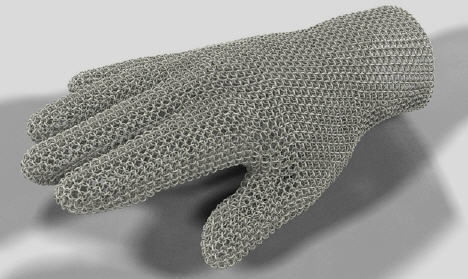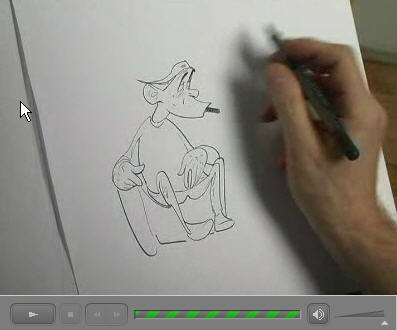Twenty years ago the consumer tech magazine to read was PC/Computing. This, in spite of its stupid name. (Spell it out: “Personal Computing Computing.”) I recall an ad from its back pages for some long-forgotten software. Buy the software and you’d get a bonus bumper sticker, reading: In the future everything will work. Those were the days of crappy dial-up modems and the crash-prone Windows 3.1, so this was high sarcasm.
In honor of the upcoming Rock the Green music festival, to be held on Milwaukee’s lakefront September 18, I submit this similarly absurd proclamation: Technology will fix our planet. What’s more, I assert that your guffaws (yes, I can hear them now) is in fact further evidence of its certitude. Here’s how:
Yes, a chain mail glove, produced by Within Technologies. It represents an amazing technology; one that uses one-tenth the metal of conventional manufacturing and arguably just as little fossil fuel. What’s more, there isn’t a single seam or joint in the whole works. It was manufactured by a printer.
Alexander Bell’s Telephonic Folly
In the future we’ll be printing things, not just pictures or descriptions of things. Things made of metal, fiber, just about any material. This printing will take place well beyond the factory floor. It will happen in the back of auto repair shops, clothing stores, hobby shops. Out of the nozzles of printers will issue the very supplies and inventory of future commerce. Someday we may even be printing our own “stuff,” right in our home.
This will save huge amounts of fuel. Needless to say, that will spare our planet from megatons of pollutants annually. And yes, I know I’m sounding all PC Computing. But contrary to the bumper sticker, I know these printers won’t work perfectly. Nothing ever does. There will be problems. But it won’t matter. The technology will arrive, whether we invite it into our lives or not. And if his particular revolution won’t take place, I’m confident another will . It will be just as extraordinary. I blogged about that one other tech revolution: Not printing things in three dimensions but the very food we eat, using living cattle, pig or chicken cells instead of metals and plastics. Yes, printing T-bone steaks.
I base my confidence — my optimism — on history. The world is full of smart people. Always has been. But we have a massive blind spot for the reality of our lives in the future because we’re limited by our imaginations.
Take the telephone. The phone has been a tool of almost universal good, aiding both business and society. It has saved lives (think: Dial 9-1-1) and saved massive transportation costs (as when you phoned ahead before driving to the store and discovering they’re sold out anyway).
I’ve written before about the phone, and how no one thought that technology would be much beyond a less precise telegram. Here’s an excerpt from that 2007 Business Journal post:
Executives in the telegraph industry couldn’t imagine that a device with no written record of the communication could be a threat to their business. In fact, legend has it that William Orton, the president of [the once mighty telegram company] Western Union … was offered a chance to buy Alexander Bell’s phone patent for $100,000. The story goes that he replied, “What use could this company make of an electric toy?”
The emphasis is mine, but you get the point.
I do suggest you click on this link to a post on my personal blog, about, of all things, growing meat in the lab. It’s another new technology that I think will be as revolutionary as the telephone.
To be fair, it’s not so much the technology that makes it revolutionary — this one uses in vitro lab culturing, which isn’t new — but the good it can do . It promises to feed the world, and in doing so conserve a staggering amount of natural resources and carbon-emitting fuels. I’m not kidding.
When they hear about culturing meat in a lab most people laugh or wince. I frankly don’t blame them. I may be a bit of a whack job to think this level of aversion can be overcome, but I do believe the writer of the New Yorker piece, who I cite in that post, when he says he expects to see it arrive, in at least a limited way, within ten years.
Read it, and I dare you to disagree. It’s that much of a game-changer.
Printing Chain Mail and Grandfather Clocks
Which brings me back to 3-D printers. They’ve actually been around for about 20 years. I saw my first one at my brother’s company, ten years ago. Originally used to print manufacturing prototypes, now they’re frequently being upgraded to manufacture the things themselves. Here’s an excerpt from a recent Economist story about them:
Far-fetched as this may seem, … people are using three-dimensional printing technology to create … medical implants, jewellery [sic], football boots designed for individual feet, lampshades, racing-car parts, solid-state batteries and customised [sic again — hey, they’re British] mobile phones. Some are even making mechanical devices.
At the Massachusetts Institute of Technology (MIT), Peter Schmitt, a PhD student, has been printing something that resembles the workings of a grandfather clock. It took him a few attempts to get right, but eventually he removed the plastic clock from a 3D printer, hung it on the wall and pulled down the counterweight. It started ticking.
Although the article focuses on the savings in raw materials (it takes only ten percent of the metal to make something complicated in this way, compared to the wasteful machining and whittling away of metal blocks), there are other clear implications for a greener planet.
It will happen when these 3-D printers become more affordable. Think about it: There was a time when only well-financed businesses could afford a fax machine. Time improved the technology and drove costs down. Now you can buy a fax machine for about fifty bucks.
What if these printers were to follow the same trajectory? At first only the largest businesses could afford to produce their own machine parts. Then smaller businesses could afford it. But they wouldn’t be faxing each other digitized pictures of documents. They’d be transmitting the digitized plans to actually make stuff.
Atoms Are A Drag
Jeff Jarvis famously said that the reason businesses like Amazon.com and Apple’s iTunes have prevailed over stores that sell real books and CDs is that moving atoms from place to place is costly. Digital transportation, by comparison, is frictionless. Atoms are a drag.
Imagine a world where the friction is taken out of moving real things around. Instead of the rotor to your car’s disk brakes arriving by truck at the repair shop, the part would arrive digitally, and perfectly configured to your vehicle. Or at least the plans for it would. Then a tiny pile of metal and composite powder, a small fraction of the size of what’s needed using today’s technology, would be fed into a 3-D printer. You’d be on the road more quickly, at a lower cost, and at a lower cost to the planet.
What do you think about a future where atoms are no longer a drag? Do we dare to dream of our grandkids inhabiting a world with more fresh water, less pollution and fewer pollution-borne illnesses?
I say we must.




